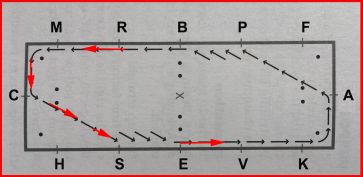Can you explain this exercise to me? It’s not in any of the tests.
(An exercise to develop lengthening)
BILL– A student found this exercise in Major Anders Lindgren’s book,Teaching Exercises. It had come out back in 1998, and I had a hand in editing it before publication, so I well know what he wanted to see.
The exercise looks like this:

You come through the corner between M and C riding into the short end of the arena energizing, engaging, and building power. It’s a good option to do this part in shoulder in. Turning at the center line, you don’t proceed directly up the middle. The turn is more like 45° and takes you on a straight line towards the second letter on the long side, in this case S. The line is as though you’re cutting a tab off the corner of the arena. As you find that line, you take the horse’s stored up energy and express it forward in powerful, lengthened strides (or if the horse is of an appropriate level in medium trot.) As you approach S, you maintain that angle relative to the track and regather/rebalance your horse in leg yielding nose to the wall. This allows you to push him back into “collection,” re-engaging his right hind leg and allowing the wall to help you make rebalancing half halts without having to pull on the reins. As the rebalancing works, you then straighten the horse parallel to the rail.
The principal points of the exercise are these:
To make a successful lengthening, start with energy and balance before the fact. Don’t try to create that energy in the middle of the movement.
Do the actual lengthening for a relatively short distance so as to maintain the balance and throughness.
Regather before you lose those qualities and do so by re-activating and re-engaging from back to front, not by using a restraining hand. The lateral movement along the rail helps keep your horse supple and less inclined to brace against the hand in the downward transition.
In our current incarnation of dressage tests this is not a radical concept. We see lots of examples of lengthenings and mediums performed on a partial or short diagonal. This was much less the case back in the early 80s when Major Lindgren was writing his manuscript. I remember in the 1970s every lower level lengthened trot was asked for immediately after a transition down from canter, as though that was the only way a horse would have accumulated enough energy to produce one. The state of the “art” at that time meant that most of those lengthenings tended to hurry, lacked cadence, and petered out across the diagonal. In fact, when the 1979 tests came out and a third test at Second Level was introduced, we were shocked that right after the centerline entrance, the first movement was a medium trot. I wasn’t the only one who reacted, “How in the world can a horse be expected to do that?”
This exercise helps develop the mindset that the lengthening should always be alive within the working or collected trot just waiting to be tapped.
